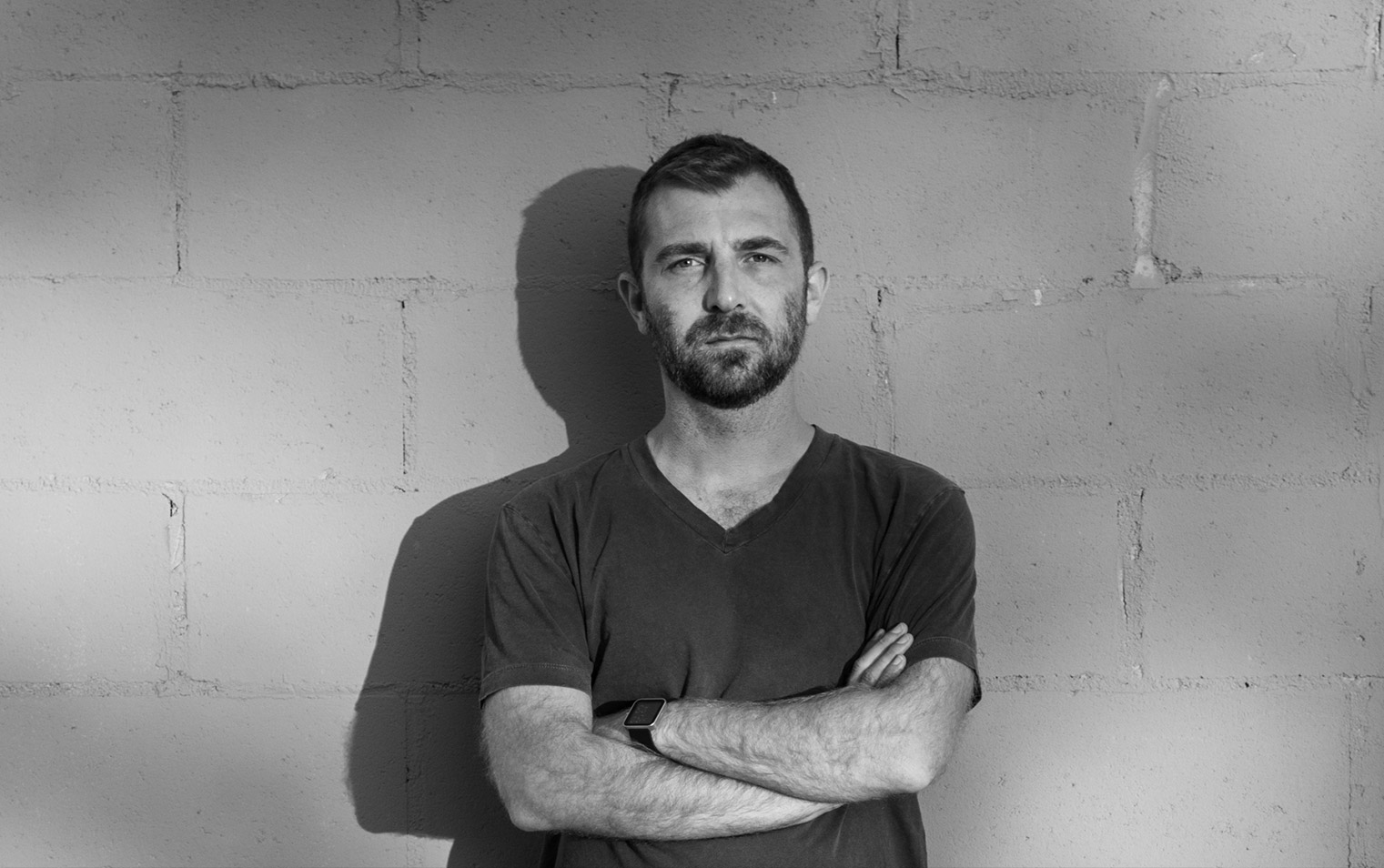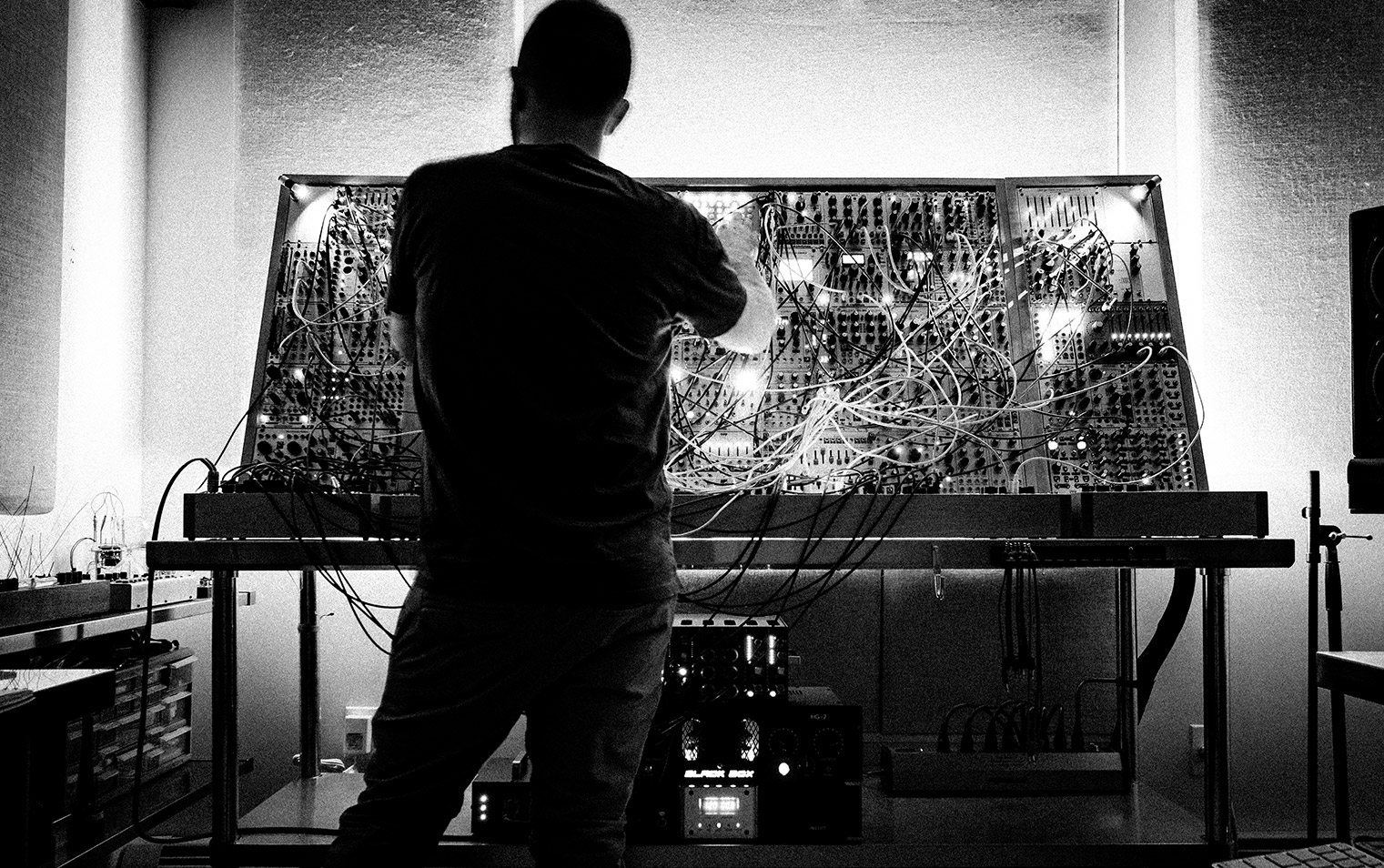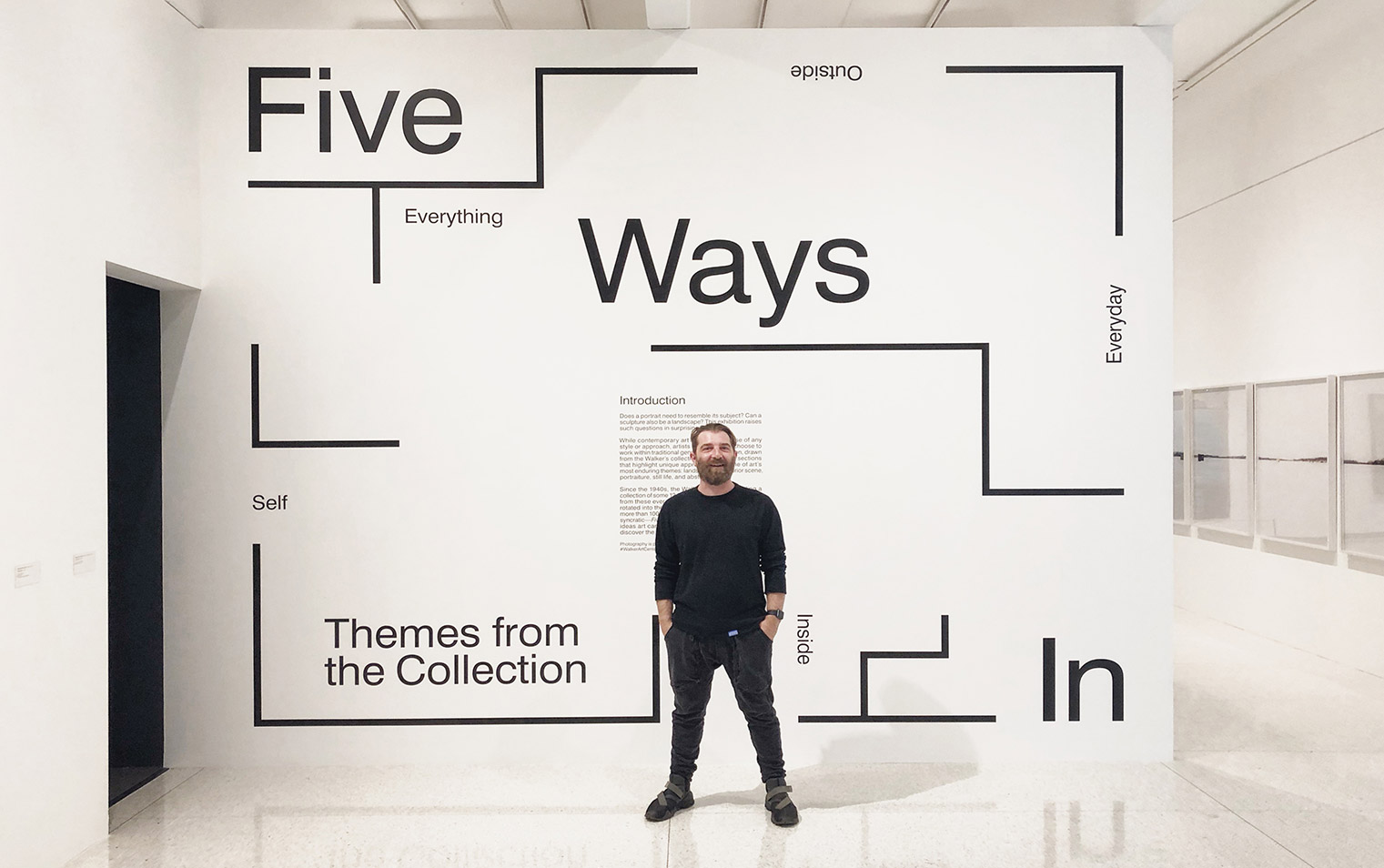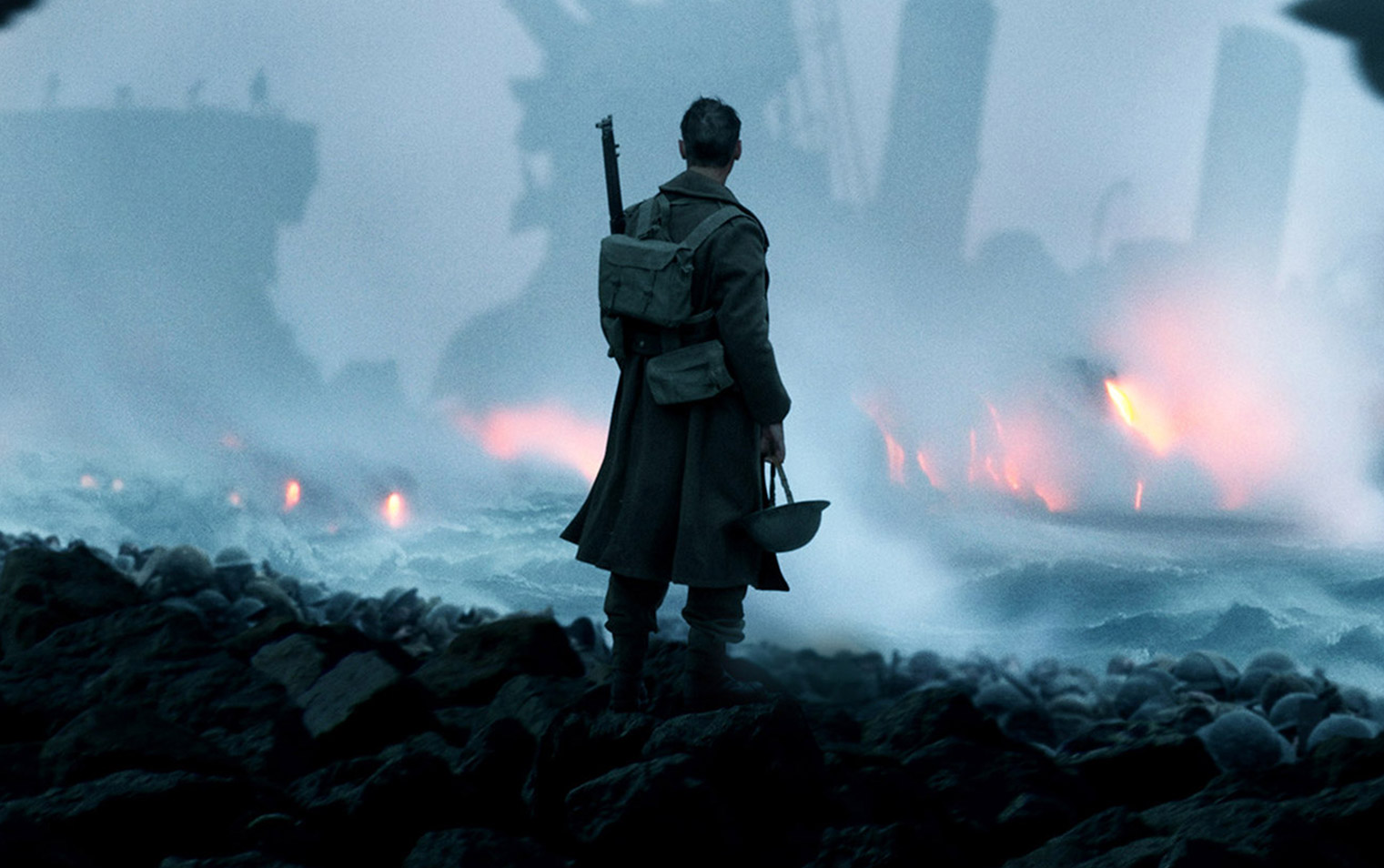
The first thing you see at Jafbox, Joseph Fraioli’s studio in West Los Angeles, is a modular synth. Just looming there, looking like an obsessive detective’s crazy wall. Jumbles of colored patch cords traverse it wildly, connecting modules together in ways that make sense only to him.
Synthesizers are made up of individual parts: oscillators produce tones, filters affect their timing, other filters affect the dynamics or feel of the tones. Most synths only let you blend the individual parts in the specific order that the designer has hard wired them. But modular synths break you out of that, letting you blend parts as you wish, ad infinitum. Exploring their possibilities is a life-long journey best suited to obsessives, alchemists, and meanderers.
Obsessive meandering alchemy is an apt description of Fraioli’s career as a sound designer and electronic musician. Fraioli, who relocated from New York in 2018, has been releasing electronic music as Datach’i since the late 90s on labels like Planet Mu and Timesig (owned by Aaron Funk/Venetian Snares). Throughout the years, he’s played with the limits of genres like drum-n-bass and techno. Sometimes his work explores the playful and melodic, other times the intense and dissonant. Fraioli’s consistency is rooted in being open, experimental, and flexible — qualities that have served him well in the world of sound design.
Fraioli’s resume in sound design is multi-layered, informed by years of investigating the possibilities of individual parts. He’s built complex, immersive installations for Kanye West at Cannes and, as a solo artist, at the Walker Art Center. He’s also created dozens of rich, sonic worlds on commercials, television series, and films (most recently on Kin, starring Dennis Quaid, Zoe Kravitz, and James Franco). In this interview with writer and musician Kerry McLaughlin, he discusses how his varied background has given him a unique approach to sound design and how staying open to accidents is the key to success.
Kerry McLaughlin: With the sound design on Kin, you mentioned that the directors wanted the technology in the film to have a magnetic energy. What does your research look like when you’re asked to come up with sound that doesn’t really have precedent yet?
Joseph Fraioli: On Kin, I knew the magnetic aspect really early. The first thing that anyone would think of is: What does a magnet sound like? The hum. They actually never hum. Magnets don’t make any sound. Unless it’s like a large electromagnetic structure, but that’s the association, so you start experimenting with that and see where it leads. Oftentimes, you’re, like, “Oh, this is exciting sonically, but it might be good for something else.” You might put it aside and find other characteristics that lead you deeper.
What I came up with was abstract. I was thinking about the characters in the film and how they were separated: the single dad, the son in jail, the adopted brother, the stripper, and these bad guys. What was happening with the technology was actually bringing these misfits together. So I used that concept of “magnetic” to add another layer of sound in the movie.
But, technically speaking, for the actual physical objects that were based on magnetism, I just did as much research as I could on electromagnetic weapons and rail guns, those kinds of things. One of my favorites was not magnetic at all. I found this thing called a hail cannon. They use them on farms when hail clouds gather. They look like strange horns — 30, 40 feet high. They have a huge blast of compressed air that creates these rings, like donut rings, that push up through the clouds and move them.
Kerry: Whoa.
Joseph: They make this big blast followed by this high-pitched ascending whirling sound. That was a big inspiration for the gun in Kin. Then I incorporated other sounds from the electronic side of exploring, recording electromagnetic fields of all my studio equipment. I’ve always been interested in listening to electromagnetic fields because if you put on headphones and have an induction coil microphone, there’s a whole other world right around you.

A hail cannon in the wild
Kerry: I’m curious about the breakdown between the different sound department roles in filmmaking: Foley, sound design, sound editing, etc. Who does what?
Joseph: In a short form-situation, a commercial project, one person such as myself, I’ll do everything — Foley, all the sound editing, all the sound design, whatever needs to be done. But on a feature film, it breaks down. It starts with the sound supervisor, who oversees the creative vision of sound for the whole project and communicates with the director and the producer to gather the information they need to delegate responsibilities to the rest of the sound department. It depends who you ask, but a lot of times, the sound supervisor will also call themselves sound designer because, technically, they’re designing the soundtrack by delegating responsibilities. Sometimes they do actually create the sounds needed to accentuate a character to build a world that’s specific to the vision of the film, but sometimes they don’t do any of that. They have other sound designers, who they’ll tell, “Hey, create all of the science fiction sounds” or whatever it may be. Additionally, sometimes sound supervisors are dialogue editors. Basically, that role can be multifaceted.
The sound designers, though, it’s their responsibility to create the world of sound and create the feeling that’s in line with the story and the intent of the director. It’s like bringing a unique voice from creating original sounds.
“It’s important to view the team as collaborative, as people you can bounce stuff off of, because you want the design to be densely layered. You can get only get so far working in a tunnel.”
Then, sound editors. You have maybe two. It depends on the size of picture. Some big movies have tons of sound editors because it’s, like, Transformers and so much is going on. But typically, smaller teams can be really efficient. The sound effects editors handle all of the backgrounds, all the ambiences, all the hard effects — doors closings, cars, and whatever it may be that’s not sound designed and not Foley.
Foley teams, they’re not typically involved in the whole process. There’s a Foley artist and an editor or, as they’re called, a walker and an editor. The editor will record the cues that the walker creates and put them in place, roughly, in the mix for the sound editors to work with. Foley covers three things: feet, which is most important, and then props — like me putting this little cactus plant down— and then cloth, any cloth rustles or movements of fabrics, which are super important for bringing the audience into the film.
Kerry: Foley is specifically the sound of feet walking or whatever and cloth?
Joseph: Feet, cloth, and props. Those are the three things that are typically managed, but in bigger productions, they’ll do more. That said, a lot of the disciplines are interchangeable. Sometimes sound editors do sound design. It’s important to view the team as collaborative, as people you can bounce stuff off of, because you want the design to be densely layered. You can get only get so far working in a tunnel. It’s less about making something really cool and abstract and more about immersing people in the film or letting the film tell you what it wants.
Kerry: You grew up in New York, started out playing music, and then releasing electronic music as Datach’i. Chart the evolution from there to sound design for me.
Joseph: I’ve always been experimenting with sound, even when I was making music in my late teens. In punk bands, I was into playing with guitar pedals and doing weird stuff as a guitar player. Then I went to an audio engineering research program in New York, and right after that, literally, the week I graduated, I had a record deal. Basically, I’d saved up all my food money for school and bought a 4-track. Then, with a synth I borrowed from a friend of mine, I made a demo and got a record deal from it. So — super lucky. I never went to college because right after that, I went on tour and released a couple albums and did that whole thing. It was absolutely fantastic.

Fraioli at his modular synth
Kerry: You went straight from high school to doing the audio engineering program?
Joseph: Yeah. Well, I took a couple years off, you know, being stupid, playing in bands. Eventually, I was, like, “I better do something.” So, I went to this program. Then yeah, through making and releasing experimental electronic music — which I still do — I got the opportunity to sonify an installation at the Museum of Modern Art. That was the first time I’ve ever worked with visuals before. Looking back on it, it was super difficult because I didn’t have a powerful computer — this was 2000 or 1999. But the experience gave me the feeling, like, I’ve always been making sounds for stories or movies [that I see] in my head, but this was making sounds for somebody who already made these visuals, and I can just kind of follow along. But I was young and thought, “This is going to be easy! I’m just going to do a bunch of these!” Sure enough, it took me another five years to get another job [in sound design]. It’s just such a hard thing to break into, so niche to begin with. Luckily, again, through music releases, I got more opportunities to do sound design. I’d been sticking with my sound work and a lot of my friends went into advertising in New York, becoming creative directors. When they needed crazy sound design, they called me.
Kerry: Did you start doing film out of commercials or—
Joseph: Yeah. Film stuff is a little bit more rare in New York, but it’s always been my favorite. I think when I was sixteen, I saw Jurassic Park, and that T-Rex roar scared the crap out of me. I was not expecting it to be that scary. At the time, I saw an interview with Gary Rydstrom, the sound designer of the film, showing how he was creating the sounds. It completely blew my mind. It still gives me chills when I hear that roar. It’s phenomenal. There’s been nothing that’s been as good, I don’t think, since then. I forgot what you asked me. I started thinking about Jurassic Park.
Kerry: Ha! Just your progression to film.
Joseph: Well, a lot of my best opportunities have come through my album releases. Music and film, they tend to bounce off of each other. When I’m working on sound design, it’s, like “Oh, I’ll do this because this thing I discovered when I was using that.” [Points to modular synth.] It’s all the process of discovery. It’s being a documentarian because you’re collecting and organizing sounds, but you’re also an explorer, finding new things. That’s my favorite part because it never ends. Whoever thinks they’re a master at something like this is fooled. There’s no way. I have over a million sounds in my library, and for every project, I’m creating and recording new sounds. It’s impossible. Every little thing is different.
Kerry: What makes excellent sound design in a film?
Joseph: That’s a really hard question to answer. It’s really particular to what the film is. It’s silly to take an award for sound. How could you compare one person’s film’s sound versus another person’s film’s sound? The opportunities were completely different! You can’t give a person an award based on their opportunity. If it was the same film, then you can judge which film sounds better. Anyway, generally, great film sound design is great storytelling with sound. That is, I think, the most valuable asset of a sound designer. We all may have the same tools and same tricks, but what makes us all different is that we think differently. Our experiences in life are different. We’re just going to approach storytelling from a different perspective.
Kerry: Are there hallmarks of lazy sound design?
Joseph: Oh, god. Yeah, there are, but I feel like it’s not their fault as much as it is their budget could’ve been tight. Or their time.
Kerry: Right.
Joseph: But my heroes — people like Gary Rydstrom and Ben Burtt, they created all their own sounds. A lot of the reason they did was because of the time period. Now everything is so much more readily accessible. You can buy phenomenal sounds online right now, but the best sounds were accidents. Like the elephant. It was a baby elephant that Gary Rydstrom used for the T-Rex roar [in Jurassic Park]. It’s not like the trumpet that you can buy a thousand versions of. It made that sound once! The angry elephant — it’s hard to record! Star Wars, Jurassic Park — these are sounds that everyone knows, every kid knows, and there’s a reason.
Kerry: When you’re doing installation work, what’s that process like?
Joseph: It’s never the same. I just did an installation at the Walker Art Center. I approached a collaborator of mine, a creative director, and said, “What if you went to a museum and there was sound to associate with the paintings to help you tell their story rather than reading some long paragraph?” He went around and asked, and the Walker was interested. Basically, what I came up with was: You have a singular painting, and there’d be two different soundscapes to tell you the story of what’s going on, but also to show you how sound can change your perception of an image. For example, Georgia O’Keeffe’s Barn. One of the soundscapes is a beautiful late afternoon sound environment, but then the other one is a really dark, almost sinister sounding environment. In the research, I learned she was really unhappy there in that environment. She didn’t love it. Once you put the dark sound up to it, all of the sudden, the loneliness comes out.

Fraioli at The Sound of Art exhibition at the Walker Art Center
Kerry: Are you using a slightly different part of your brain than when you do film work?
Joseph: Yeah. You can just twist things around. Your regular surround system, you can just use it in a different context for what you want to do in the space because they’re all experiential. I did this project with Kanye West for his Cool Summer album (2012) that, actually, no one ever really saw. It was a seven-screen film that played only a couple days at [the] Cannes Film Festival. It had a pyramid that OMA designed. It was massive — three big screens that were square in front and then 16 x 9 screens that were massive on the sides, above and below you. It’s almost like a live version of VR that he created, way ahead of its time. We had to create a dual 5.1 system where there was a vertical 5.1 and a horizontal 5.1. The specs of the channels didn’t really work the way that a typical system worked, but once you got into it, it was just so amazing. Like, someone is climbing down a ladder — I think I still can’t really say anything about it, but stuff that’s happening on the screen is just following you sonically. It was great. I just wish that more people could’ve experienced it.
Kerry: You still can’t talk about it?
Joseph: I don’t know. There’s nothing about it online. The point is that every experiential installation thing is completely different. It’s so nice to jostle your brain and challenge yourself, especially with the large-scale stuff. There’s a lot on the line. It’s like a game.
Kerry: What would be a fantasy project for you to work on?
Joseph: I like variety. I love working on any opportunity to tell story with sound.
“I like to be a little bit nervous because I work really well under pressure. That’s when the good stuff happens.”
Kerry: So, a mix of installation and film and—
Joseph: I try to keep it all over the place because I feel more inspired when I’m being jolted a little. I like to think, “Oh, yeah. This is installation. I don’t know how to do it.” I like to be a little bit nervous because I work really well under pressure. That’s when the good stuff happens.
Kerry: Has there been any sound design recently that surprised you or that you’ve noticed more than others?
Joseph: I love Chernobyl. The whole series, the music, the sound design, even just the background — finding the right siren sounds. There’s a lot of TV that’s getting really up there in terms of competing with film. Film-wise, Dunkirk was amazing. Richard King is a hero of mine. He always just knocks [it] out the park. It’s hard to find those moments where there’s an opportunity to create something that’s unique, identifiable, and going to resonate with an audience.

Still from Dunkirk (Source: BagoGames)
Kerry: “Identifiable” seems key because it could be an authentic sound, but so what? It might not resonate.
Joseph: Absolutely. Just because something’s authentic, it doesn’t mean anything. Or original doesn’t mean good. It can be uniquely garbage, right? It’s usually just, like, an accident. It’s what I’ve learned with working with the modular synth — the more you’re in the situation where accidents can happen, the less control that you’re putting upon yourself. The more open you are, the better sounds you’re going to get.
Kerry: What have been some of your favorite sound discoveries? Something you recorded that surprised you how it came out?
Joseph: Just recently, I recorded through a conch shell. It came out really cool — these strange sounds that were meant for a science fiction project, but it’s basically just recording the ocean and planes flying overhead through a conch shell. On that same recording trip, in Palos Verdes, there’s a particular beach with really big rocks. The sound that happens when the water flows back into the ocean over these rocks is so amazing. My wife Sarah and I, we recorded it with a hydrophone, an underwater microphone, as well as overhead microphones just to get the sound naturally as it’s occurring and mix them together. I wound up using it for like a sound of a heartbeat type of thing. It was a really beautiful texture, but liquid-y at the same time, moving liquid.
Kerry: Is there any direct path to getting into sound design?
Joseph: I don’t know. Everyone I know got into it in a weird way. There’s people that go to film school and get internships and get into it that way. Nowadays, there’s even more programs because of gaming — schools that specialize in gaming design and sound. It’s a little bit different than working on linear formats, but that’s one way to do it. I’m trying to think if I could say something to help people get into it, but my experience was so weird. I feel that so many people’s experiences are weird.
Kerry: Yeah, my whole life path has been weird.
Joseph: Right? I think that’s normal.






